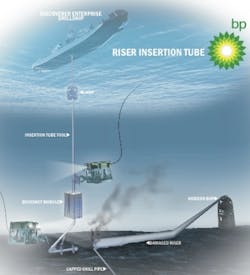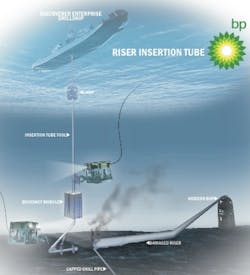May 15, 2010 -- Response crews continue with efforts to contain and clean up oil spilling into the waters of the Gulf of Mexico, despite a setback in the latest attempt. Overnight, engineers tried inserting a small, 6-inch tube into the broken 21-inch well pipe on the sea floor nearly a mile below the surface (see figure).
Suttles said a second attempt is planned and should be underway by this evening. The siphon is not expected to stop the leak, just contain it. BP believes it will be able to capture about 85% of the oil using this method.
Meanwhile, deployment of the 'top hat' containment box is still planned for next week.
On Friday, BP was cleared by EPA for full-scale use of underwater dispersants. The expectation is that by applying dispersants at the source of the breach, the oily substance will be broken up into smaller pieces, allowing it to disperse more quickly in the water. Suttles said that it "seems to be working."
The use of subsea dispersants has been a controversial subject because it's never been done before and the effects are unknown. EPA conducted testing over the past week as BP engineers deployed the subsea dispersants on a smaller scale. The agency is confident that it’s safe to proceed with full-scale use, but said it will closely monitor progress and will reverse its decision if evidence of adverse impact emerges.
Over 450,000 gallons of chemical dispersants have been used on the surface, and over 28,000 gallons of subsea dispersants have been applied.
EPA and the Coast Guard have emphasized that use of dispersants is "just one tool in the toolkit." Traditional strategies are also being employed. These include controlled burns, absorbent booms, oil skimming, and containment booms. To date, more that 1.2 million feet of containment boom has been deployed.
Track movement of the spill online >
Related Articles
BP oil spill: Cleanup battle rages on in waters of Gulf of Mexico >
BP oil spill: Update on cleanup of gulf waters, underwater video released>
BP oil spill: Clean up of gulf waters continues>
BP oil spill: Measures to mitigate wetland damage, stem flow ...>
BP oil spill: Clean-up attempt fails, wetlands under grave threat>
###




